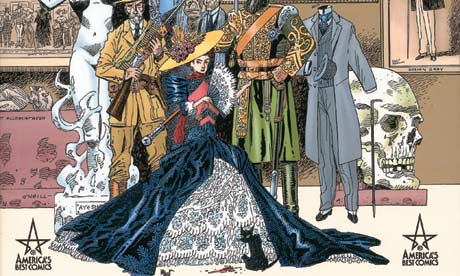Literary characters – from James Bond to Fanny Hill – and authors themselves often pop up in comics and graphic novels. Here's a personal list of favourites


Worlds collide … The League of Extraordinary Gentlemen. Photograph: Americas Best Comics. Click image to enlarge
Authors and literary figures frequently make guest appearances in superhero comics, whether explicitly or in disguise – Grant Morrison inserted himself as a character in Animal Man, while the Green Arrow is clearly a modern Robin Hood. Comics have also adapted the literary classics – Marvel's Last of the Mohicans, for instance – to bring the canon to a broader audience. These 10 examples demonstrate the criss-crossing, intertextual relationship between comic books and more traditionally literary texts.
Read all ten at The Guardian.
1. Haunted Knight by Jeph Loeb and Tim Sale
Loeb and Sale are now most celebrated for The Long Halloween and its sequel Dark Victory, both of which inspired Christopher Nolan's The Dark Knight; but prior to those graphic novels, they worked together on three Halloween tales for the monthly title Legends of the Dark Knight. In the third, Ghosts, a sleepless Bruce Wayne is visited first by his father, in Marley-like chains, then by Poison Ivy, and finally by a spectral Joker, who takes Batman to his own grave. Like Scrooge, Wayne learns a new appreciation of life from his encounter with death, and starts a charitable foundation next morning.2. Shade, The Changing Man, # 31 by Peter Milligan, Colleen Doran and Mark Buckingham
Peter Milligan resurrected Shade, a psychedelic Steve Ditko superhero, for DC's 1990s line of alternative comics, and plunged him into a fractured, self-referential road movie that crossed the United States and, in this issue, time-travelled back to Paris 1937. James Joyce and Ernest Hemingway wake up from a drunken sleep to find Shade bursting into their reality, his multi-coloured coat swirling around him like a Picasso painting. "Ineluctable morbidity of the temporal!" exclaims the Irishman. Hemingway is more prosaic: "Tell me who you are before I smash your face in." It takes Gertrude Stein to sort things out.3. Planetary by Warren Ellis and John Cassaday
Geoff Klock's academic monograph, How to Read Superhero Comics And Why, sees Planetary as a meta-commentary on different eras in popular fiction, fighting it out in textual combat to determine the shape of the superhuman to come. So analogues of DC Comics heroes defeat the pulp characters of the previous age and, in this issue, one of Ellis's protagonists, pale-suited cool dude Elijah Snow, kicks down the door of Sherlock Holmes's library to tell the ageing detective his time is up. Holmes releases his bodyguard, Dracula, but the age of 19th century fiction ends violently as Snow turns the count to ice and boots him in the frozen crotch.4. Arkham Asylum by Grant Morrison and Dave McKean
Published at the height of the late-1980s graphic novel boom, Morrison's Batman hardcover is subtitled "A serious house on serious earth" – fair warning of a superhero story that's trying too hard, even if most readers didn't recognise the reference to Philip Larkin's Church Going. If the book is a house, its architecture is taken not from Larkin, but from Carroll: quotations from Alice open and close the story, and the underpinning concept is that Batman's rogue's gallery of villains are just himself, seen through a looking-glass. Dave McKean's Mad Hatter, based on Sid James, is a highlight.5. Lost Girls by Alan Moore and Melinda Gebbie
Alice also appears, older and silver-haired, under the name Lady Fairchild, in Moore and Gebbie's controversial narrative about three heroines from children's literature, each grown up and recalling her own erotic awakening. Alice Fairchild is joined in an Austrian hotel by Dorothy Gale – who soon meets a man with a fetish for silver shoes – and JM Barrie's Wendy, now in a loveless and sexless marriage. Peter is long gone, a repressed memory from her past who haunts her through glimpsed shadows.Read all ten at The Guardian.

No comments:
Post a Comment